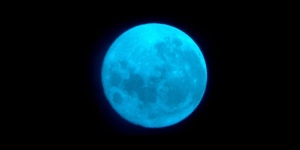Blog
Once in a Blue Moon
31 July 2015
 Brian Koberlein
Brian KoberleinYou might have heard that tonight’s full moon is a blue moon, since it is the second full moon in the same month. While this is the most common definition for “blue moon,” it is not the only definition, nor even the oldest.
The earliest references to a blue moon dates to the 1500s, and referred to an impossibility or absurdity, much like we would use the phrase “when pigs fly.” It is possible, however for the moon to truly appear blue. The most widespread incidence of modern history occurred after the eruption of Krakatoa in 1883, which sent so much ash into the atmosphere it produced brilliantly red sunsets and visibly blue moons all across the globe for nearly two years. As a result, the phrase “once in a blue moon” came to mean a rare occurrence.
Astronomically, the phrase has three possible meanings. The first is the second full moon of a given month, of which tonight’s full moon is an example. The second is a truly blue moon. Whether tonight’s moon falls into that category, you’ll just have to go outside tonight and find out. The third definition is the third moon of four in a given season marked by the solstices and equinoxes. Our calendar year consists of 12 months, and so each season is about 3 months long. But a lunar cycle (the time it takes the moon to go from full moon to full moon) is about 29.5 days, so it is possible to have 13 full moons in a given year, which means one season will have four full moons, the third being a “blue moon.”
Whichever definition you prefer, if your evening is clear you can look up at our moon in its full phase. It is a huge moon for a planet our size, and there is no other planet in our solar system where you could have such a view.